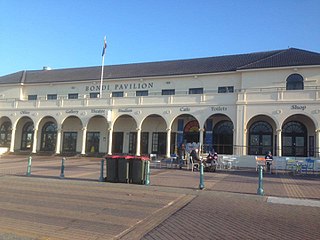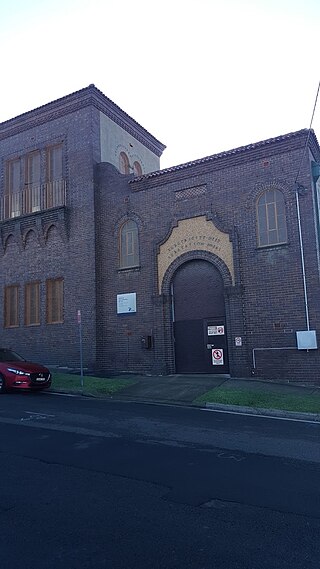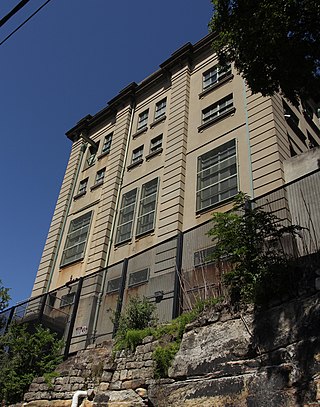Bondi is a suburb of eastern Sydney, in the state of New South Wales, Australia, seven kilometres east of the Sydney central business district, in the local government area of Waverley Council.

The Sydney County Council (SCC) was formed in 1935 to produce electricity and operate the electricity network in a number of municipalities in metropolitan Sydney. Unlike other New South Wales county councils, which were voluntary associations of local councils to undertake local government activities permitted or required of them by the Local Governnment Act 1919, Sydney County Council was established under a separate piece of legislation by the state government to perform the electricity distribution and streetlighting operations of the local government areas concerned. On its establishment it assumed control of the Electricity Department of the Sydney City Council, which was already supplying electricity to other municipalities. In 1952, the SCC lost most its electricity generation functions to the Electricity Commission of New South Wales and retained only its distribution functions. The SCC was merged with other municipal county councils in 1990 to form Sydney Electricity.

Orion New Zealand Limited (Orion) is an electricity distribution company, based in Christchurch, New Zealand.

The provision of electricity in Queensland required a considerable degree of pioneering, innovation, and commitment. Queensland proved to be a pioneer in the supply of electricity in Australia, with the first public demonstration in Australia, the first recorded use for public purposes in the country, the first Parliament House in Australia and the first commercial operations in Australia all occurring in Brisbane.

Windsor Town Quarry Park and Tramways Substation No. 6 is a heritage-listed former quarry with electrical substation at 356 Lutwyche Road, Windsor in the City of Brisbane, Queensland, Australia. It was built from c. 1926 to c. 1928. The park and substation were added to the Queensland Heritage Register on 31 May 2005. There is another, larger substation building, Tramways Substation No. 13 which was designed by Frank Gibson Costello and became operational in June 1949.
The electricity supply in Brisbane has been an important part of the economic and social development of the city of Brisbane, Queensland, Australia.

St. David's Road Depot is a heritage-listed former electricity substation at 11 St Davids Road, Haberfield, Inner West Council, Sydney, New South Wales, Australia. It was built in 1931. It is also known as the former ELPSC Substation; former Substation No.1518. and the Relay Test Centre. The property is owned by Ausgrid. It was added to the New South Wales State Heritage Register on 2 April 1999.

Electricity Substation No. 167 is a heritage-listed electrical substation at 93 Parramatta Road, Auburn, Cumberland Council, New South Wales, Australia. It was designed and built from 1924 to 1929 by the Municipal Council of Sydney, with the City Architect being responsible for the design. It is also known as #167 'AUBURN' 33KV ZONE SUBSTATION. The property is owned by Ausgrid. It was added to the New South Wales State Heritage Register on 2 May 2008.

The Balgowlah Substation is a heritage-listed former electrical substation and now child care centre located at 83 Griffiths Street, Balgowlah, Northern Beaches Council, New South Wales, Australia. It was built in 1928. It is also known as #15003 Balgowlah 33KV Zone Substation. The property is owned by Ausgrid, a privately owned energy utility company. The property was added to the New South Wales State Heritage Register on 2 April 1999.

The Manly Substation is a heritage-listed electrical substation located at 34a-36 Whistler Street, Manly, Northern Beaches Council, New South Wales, Australia. It was built in 1945. It is also known as #15009 Manly 33Kv Zone/Residential Unit. The property is owned by Ausgrid, a privately owned energy utility company. The substation was added to the New South Wales State Heritage Register on 2 April 1999.

St Anne's Church is a heritage-listed Roman Catholic church located at 60 Blair Street, North Bondi, Waverley Municipality, New South Wales, Australia. The church was designed by Joseph Fowell and Kenneth McConnel, and built from 1934 to 1964 by R. M. Bowcock. It is also known as St. Anne's Church and St Anne's Shrine. The property is owned by the Sisters of Mercy and it was added to the New South Wales State Heritage Register on 26 May 2006.

The Bondi Beach Cultural Landscape is a heritage-listed former Turkish baths, pavilion with dressing cubicles, dining rooms, sunbaking, shops and ballroom and now art gallery, pavilion, theatre and open air cinema located at Queen Elizabeth Drive, Bondi Beach, Waverley Municipality, Sydney, New South Wales, Australia. The pavilion was designed by Robertson and Marks, with Leith C. McCredie the architect. The Bondi Surf Life Savers' Club, erected c. 1934, was designed by Ross & Rowe. The Bondi Pavilion was designed by John Howie & Sons. The cultural landscape includes the beach itself, Bondi Surf Pavilion, Bondi Park and Bondi Surf Life Saving Club and the North Bondi Surf Club. The landscape was added to the New South Wales State Heritage Register on 23 May 2008.

Paddington Substation is a heritage-listed electrical substation built in 1926 and located at 1 Young Street, Paddington in the Municipality of Woollahra local government area of New South Wales, Australia. It is also known as Substation #342 Paddington 33Kv Zone. The property is owned by Ausgrid, an agency of the Government of New South Wales. It was added to the New South Wales State Heritage Register on 2 April 1999.

The Electricity Power House is a heritage-listed electrical substation located at 23 Albany Street, Crows Nest, North Sydney Council, New South Wales, Australia. It was built in 1927. It is also known as Electricity Sub-Station No. 187. The property is owned by Ausgrid, an agency of the Government of New South Wales. It was added to the New South Wales State Heritage Register on 2 April 1999.

The Cammeray Substation is a heritage-listed electrical substation at 143 Bellevue Street, Cammeray, North Sydney Council, New South Wales, Australia. It was built during 1915. It is also known as Substation - Bellevue, Cammeray and #77 Pine Street. It was added to the New South Wales State Heritage Register on 2 April 1999.

The Electricity Substation No. 341 is a heritage-listed Electrical substation at 60 Bundock Lane, Randwick, City of Randwick, New South Wales, Australia. It was built in 1929. It is also known as #341 Randwick 33Kv Zone and Canberra Street substation. The property is owned by Ausgrid, an agency of the Government of New South Wales. The substation was added to the New South Wales State Heritage Register on 2 April 1999.

The Electricity Substation No. 349 is a heritage-listed electrical substation at 2S Frances Street, Randwick, City of Randwick, New South Wales, Australia. It was designed by Walter Frederick White, City Architect's Department and Municipal Council of Sydney and built during 1930 by J Rutherford. It is also known as #349 Princes Street substation. The property is owned by Ausgrid, an agency of the Government of New South Wales. It was added to the New South Wales State Heritage Register on 2 May 2008.

The Pymble Substation is a heritage-listed electrical substation at 982–984 Pacific Highway, in the Sydney suburb of Pymble, in the Ku-ring-gai Council local government area of New South Wales, Australia. It was built from 1926 to 1928. It is also known as #195 Pymble 33KV Zone/Depot. The property is owned by Ausgrid, an agency of the Government of New South Wales. It was added to the New South Wales State Heritage Register on 2 April 1999.

Taylor Square Substation No.6 and Underground Conveniences is a heritage-listed electrical substation and underground public toilets at the intersection of Taylor Square, Oxford, Forbes and Bourke Streets, in the inner city Sydney suburb of Darlinghurst in the City of Sydney local government area of New South Wales, Australia. Both the substation and the underground conveniences were designed by Robert Hargreave Brodrick and built from 1904 to 1907, with Owen Ridge & Sons building the substation and G. D. Getherson the underground public conveniences. The property is owned by City of Sydney. It was added to the New South Wales State Heritage Register on 2 July 2004.

The Argyle Street Railway Substation is a heritage-listed railway electric substation located at Trinity Avenue, in the inner city Sydney suburb of Millers Point in the City of Sydney local government area of New South Wales, Australia. It was built in 1932 by Dorman, Long and Co. It is also known as Sydney Harbour Bridge Substation. The property is owned by RailCorp, an agency of the Government of New South Wales. It was added to the New South Wales State Heritage Register on 2 April 1999.



















